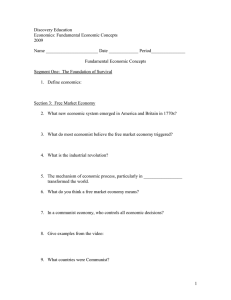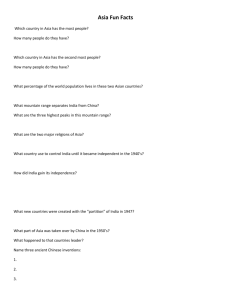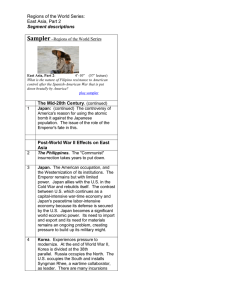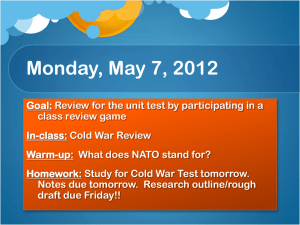East Asia, Part 1
advertisement
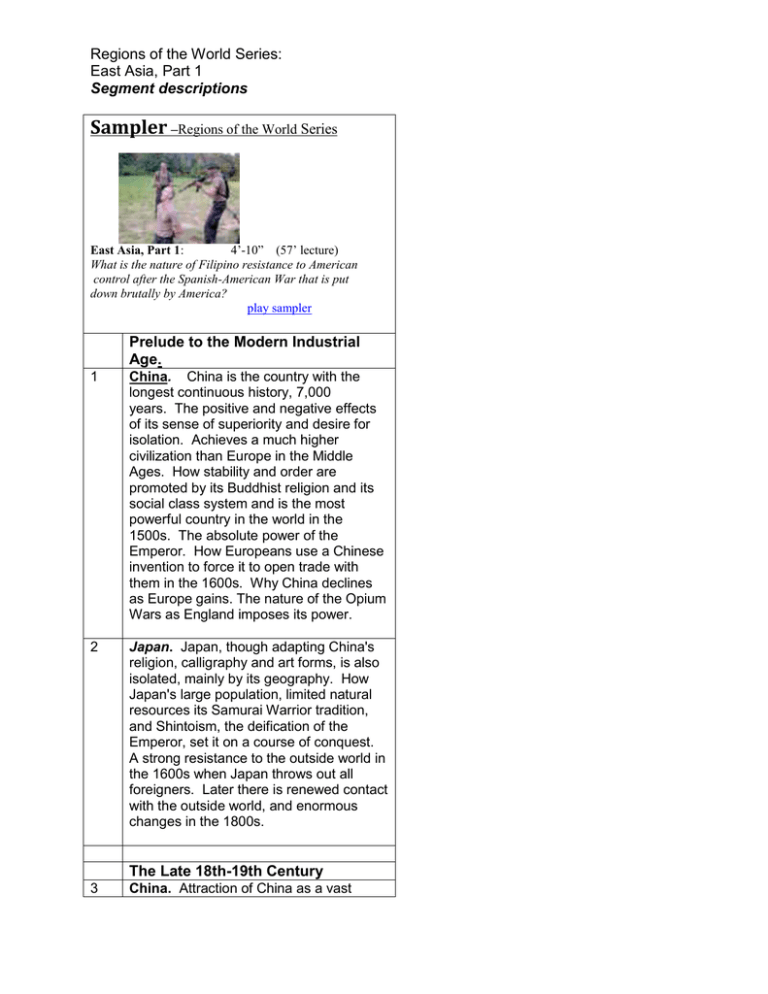
Regions of the World Series: East Asia, Part 1 Segment descriptions Sampler –Regions of the World Series East Asia, Part 1: 4’-10” (57’ lecture) What is the nature of Filipino resistance to American control after the Spanish-American War that is put down brutally by America? play sampler Prelude to the Modern Industrial Age. 1 China. China is the country with the longest continuous history, 7,000 years. The positive and negative effects of its sense of superiority and desire for isolation. Achieves a much higher civilization than Europe in the Middle Ages. How stability and order are promoted by its Buddhist religion and its social class system and is the most powerful country in the world in the 1500s. The absolute power of the Emperor. How Europeans use a Chinese invention to force it to open trade with them in the 1600s. Why China declines as Europe gains. The nature of the Opium Wars as England imposes its power. 2 Japan. Japan, though adapting China's religion, calligraphy and art forms, is also isolated, mainly by its geography. How Japan's large population, limited natural resources its Samurai Warrior tradition, and Shintoism, the deification of the Emperor, set it on a course of conquest. A strong resistance to the outside world in the 1600s when Japan throws out all foreigners. Later there is renewed contact with the outside world, and enormous changes in the 1800s. The Late 18th-19th Century 3 China. Attraction of China as a vast Regions of the World Series: East Asia, Part 1 Segment descriptions market for Europe's increased industrialization. Too large for direct takeover, spheres of influence are staked out by European powers for economic control and exploitation. China is humiliated by many European practices on its soil. Resistance by the Chinese. The defeat of Boxer Rebellion at the end of the 19th century. 4 Japan. U.S. Admiral Perry's gun ships forcefully opens Japanese trade in 1864, also causing Japan to recognize its need to modernize. Although resisted by traditionalists, Japan comes to terms with modernity, with all its implications, negative and positive. Japan becomes a significant power by the late 1800s. How European countries anger and frustrate Japan by blocking its fruits of victory in its wars with China in 1880s and with Russia in 1905. On a wave of nationalism and expansionism, Japan occupies Korea, which resists but also sees Japan as a path to modernization. The Early 20th Century. 5 China. European spheres of influence is altering with the U.S. now in the picture as the American Empire begins with the defeat of Spain in Spanish-American War. 6 Philippines. U.S. sees the Philippine Islands, gained in the Spanish-American War, as a stepping stone to Asia, and especially China. Philippine resistance to American control continues for years and is brutally put down by the U.S. 7 Vietnam. Resists domination by China. Later Vietnam resists French control and economic exploitation which is carried out with harsh methods. After World War I, Wilson calls for selfdetermination but colonial empires are excluded. The rise of Vietnamese nationalism with Ho Chi Minh leading a Regions of the World Series: East Asia, Part 1 Segment descriptions Vietnamese communist party. 8 China. The fall of the last dynasty in 1911 and establishment of a republic. Sun Yat-sen wants to democratize and modernize, and be independent of American control. Has cordial relations with Bolsheviks in Russia. War lords still control large regions of China. The Communist Party is created in 1921. Russia advises it to cooperate with the ruling Kuomintang Party, with disastrous results for the communists. Chang Kai Check suppresses the Communist Party which survives by fleeing to the interior. 9 Japan. In the 1920s - 1930s, with its growth, modernization, industrialized militarism, Japan has become expansionist. Its Samurai tradition is its version of fascism, and allies itself with the Axis. With its eyes on China to satisfy its material needs, Japan invades Manchuria in 1931, and launches a brutal all-out war on China in 1937. The Mid-20th Century 10 China. Mao leads the Communist remnants on a one-year, 6,000 mile "Long March" north to a safe haven. They develop a positive relationship with the peasants by strictly enforcing a close and respectful participation in their lives. A cease-fire is arranged between Mao and Chang to combine against the invaders. Later there are the issues of who fought the better fight against the Japanese, and the corruption of Chiang. 11 Japan. The attack on Pearl Harbor and Japan's formidable military force with its major conquests of World War II in the South Pacific and the building of its East Asia empire. The resistance of China. Vietnam (Indo-China) fights a guerilla war and has a friendly relationship with the U.S. The U.S. island-hopping Regions of the World Series: East Asia, Part 1 Segment descriptions war. The tide turns and and U.S. forces approach Japan in 1945.
